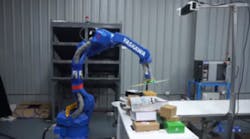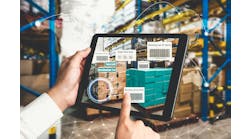To meet stringent demands and stay competitive amid the global pandemic and beyond, a growing number of manufacturers are implementing more affordable, versatile and agile robots to optimize operations. This is especially true for material handling applications like assembly, picking, packing, palletizing, part transfer and machine tending.
The robot segment for the automated material handling equipment market continues to dominate the market size for installed automated material handling equipment. As it is expected to grow at a compound annual growth rate (CAGR) of 12.0% from 2021 to 2026, company leaders that hesitate to implement advanced technologies, including robotic automation, run the risk of falling behind in today’s high-mix, low-production industrial landscape.
Key Drivers for Material Handling Robot Growth
Traditionally implemented to help manufacturers gain operational efficiency, improve product quality and reduce production costs, robots are now being implemented for newer, eclectic reasons:
1. Evolving Consumer Behavior
An issue before the pandemic, consumer demands continue to grow in complexity, requiring greater flexibility on the production floor. While large product runs in low-mix manufacturing environments still happen, the ability to accommodate product customization and personalization quickly with the utmost quality is vital. To effectively manage the uptick for this product differentiation, company leaders are choosing to move from fixed automation layouts with task-specific machinery to flexible automation options with more adaptive technologies, providing employees with robust yet versatile tools required to succeed.
With this in mind, the use of fast, compact industrial robots is transforming many primary and secondary packaging requirements, while higher payload extended-reach models are optimizing end-end-of-line tasks. Designed to work safely with or alongside humans, highly portable easy-to-program collaborative robots (cobots) are also facilitating extremely productive workspaces, enabling fast deployment and redeployment on demand.
2. Growing Automation Confidence
The evolution of safety standards, as well as the development of easy-to-use robots, has company leaders more comfortable than ever about robotic implementation. Gaining the ability to optimize operations and manage the influx in consumer product variety is easily achievable. Whether a robot features an industrial or collaborative design, humans can now work safely with or in close proximity to robots, completing defined tasks as needed. Much of this flexibility is the product of four collaborative robot modes:
Safety Monitored Stop
Ideal for re-stocking tasks, this mode is frequently used with an industrial robot and is implemented to detect human entrance into a monitored workspace, momentarily pausing robot movement until a person is clear. Compatible with all robots that come equipped with a Functional Safety Unit (FSU), safety monitored stop uses a robot controller housed processor that monitors robot range of motion, as well as speed functions.
Power and Force Limiting
Often used for light assembly, machine tending, picking, packing and palletizing applications, cobots like the HC10XP and HC20XP feature Power and Force Limiting (PFL) technology that make them inherently safe by design. With dual channel torque sensors in all joints to constantly monitor force, robots like this quickly react to contact, making them ideal for frequent human-robot interaction.
Hand Guiding
Ideal for basic pick and place jobs, this unique feature found on select PFL collaborative robots allows a robot programmer to teach a program path to the robot by physically guiding it from point to point. Simplifying the programming process, robot-mounted push buttons enable the use of hand guiding, as well as safe human-robot interaction
Speed and Separation Monitoring
Also well-suited for pick and place applications where frequent human-robot interaction is required, this mode is typically used to optimize cycle times. Allowing both industrial and collaborative robots to work within a pre-defined safety zone, speed and separation monitoring employs the use of laser scanners or light curtains to detect human movement near the robot coupled with the FSU. When a human worker enters the monitored area, the robot slows down to a safe speed.
Adding to automation confidence is the availability of easy-to-use robots coupled with intelligent tablet-based teach pendants. Featuring leading Human Machine Interface (HMI) features, these teach pendants allow operators to guide a robot using familiar commands via a “click and program” approach. Similarly, these teach pendants are simplifying the programming process and creating more accurate path planning for safe production. For example, the highly intuitive Smart Pendant radically changes the way a robot is programmed by making the operator the frame of reference, eliminating the use of conventional coordinate (X, Y, Z) frames. Known as Smart Frame, this along with features like descriptive commands and touch-to-edit job editing functionality are providing an easier learning curve for faster implementation of a robot system.
Another piece of the confidence puzzle is being filled via standard programming environments that eliminate the need for proprietary languages. Operators can easily oversee robots and their surrounding components through motion control platforms or Programmable Logic Controller (PLC) solutions, such as MLX300 controller software. This eases robot setup through simplified communications and increases production with Singular Control™ of multiple mechanisms including industrial robots, servo systems and variable frequency drives. Overall, this user-friendly approach to automation empowers manufacturers to tackle dynamic packaging needs that distributors, retailers and consumers often have.
3. Re-evaluating Supply Chain Operations
The uptick in demand for general use products throughout the pandemic, as well as the surge in online shopping, is causing a number of company leaders to actively assess operations and address logistical dilemmas with robotic automation to meet on-time delivery. With almost 80% of distribution centers currently operating manually with a limited labor pool2, the value of integrating flexible easy-to-use robots is being realized.
From retrofitting current manufacturing and warehouse facilities to creating Distributed Manufacturing Systems (DMS), much of the increase in robotic adoption over the last year is serving to optimize supply chain flow. A promising approach, DMS maintains a network of regionally dispersed facilities intertwined with workspaces that are managed by human workers and interspersed with smart technologies including industrial, collaborative and mobile robots.
With the latter concept in mind, dynamic factory and distribution environments are meeting various production needs by combining robots, vision systems, custom end-of-arm tooling (EOAT) and more on robotic platforms that are capable of maneuvering autonomously throughout a facility to complete a programmed task. These highly flexible, autonomous robots (AMRs) efficiently and safely perform jobs like picking, sorting and on-demand material transport.
Perhaps the largest need for robotic automation, where the supply chain is concerned, is for parcel sortation or piece-picking. Manually identifying and processing items such as boxes, envelopes and polybags (often from a conveyor) for sorting or further diverting to a specific destination is tedious, injury-prone work that opens the door to sorting inaccuracy. To better position their manufacturing and warehousing facilities for success, company leaders are transferring manual operations into automated areas that can accurately and efficiently manage the high volume of parcels required. Key areas where robots are being implemented include inbound bulk receiving of items, converting bulk flow of items into singulated flow, and sortation or diversion of parcels according to their destination.
4. Cultivating a Highly Reliable Workforce
Whether it is maintaining product volumes around the clock, or keeping human workers satisfied and safe, there are a handful of reasons company leaders are feeling compelled to bolster their workforces through robotic automation. Using robots to complete basic material handling tasks, while freeing human workers to perform higher value-added jobs within a company is often a “win-win” outcome. Hard jobs are being handled by highly capable robotic arms, while human workers are being saved from worker burnout.
Capable of operating 24 hours a day, robots are extremely advantageous at maintaining product workflow, especially in a post-Covid industrial landscape, where slowing or stopping production for physical distancing or sickness outbreaks is a new reality. This is conveniently true for food preparation facilities, where IP67-rated industrial or collaborative style robots with NSF H1 certified food-grade grease for food or consumer product packaging are helping to improve hygiene and overall safety.
Ideal Locations for Robotic Automation
While many new entrants are interested in robots for sortation and truck loading / unloading, it is highly suggested that a thorough risk assessment is performed with an experienced robot supplier or integrator before settling on a specific handling application. With most facilities set up for a manual workforce, space is at a premium. Robots must not only perform the specified task but also, they should be able to operate safely in close proximity to humans.
Furthermore, with most manufacturers and logistics companies already heavily invested in current infrastructure, retooling everything for robots and other types of automation is nearly impossible without significant investment. For this reason, robots and any related peripherals or software must be flexible enough to integrate with machines and equipment that already exist on the factory floor.



